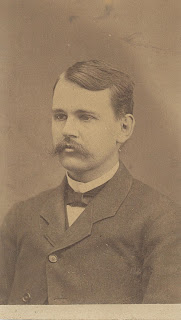 |
| Woman, unknown year, Gardiner, Maine. |
October is American Archives Month, so it couldn’t be more exciting or appropriate that we finally completed renovations of our Community Archives Room and moved back in last week! We’re still shuffling some things around, settling into the space, and waiting for some furnishings – so, stay tuned for more!
In the meantime, some things never change. As thorough as we try to be with documenting and recording information about historic items and photographs, mysteries will always exist. We have many unidentified portrait photographs in our collection and most offer very few clues as to who the subject is.
 |
| Children photographed by S.C. Stinson, a Gardiner Photographer who worked with the ambrotype process in the 1860s. |
Most photographs, such as the cartes de visite and cabinet cards included here, include the name of the photographer and location of his or her studio. These photographs were all taken (or reproduced) here in Gardiner, each by a different photographer. Although Gardiner had many photography studios over the years, we can identify a time frame in which images were produced by knowing when the photographers worked in town. Newspapers and directory listings have helped us build such a timeline, but some photographers left and came back, others worked steadily for decades, and still more names keep coming out of the woodwork (like Hamlin, above).
 |
| Man, “Photographed by Clark,” 1860s. |
 |
| Man, 1880; “Photographic Studio of Mrs. J.K. Barker.” |
Fashions of clothing or hair, styles of furniture and set pieces, and also the format and design of the photograph itself provide additional clues. Women’s hairstyles and men’s facial hair followed distinct trends through the years and clothing and props can indicate time frames, ethnicity, wealth, career, interests and more.
 |
| Woman, early 1890s; J.S. Variel, photographer. |
 |
| Child, early 1890s; A.W. Kimball, photographer. |
Similarly, as photographic processing improved and changed, styles emerged to distinguish one print from another. Colored borders became popular in the late 1880s and fancy edges emerged in the 1890s. Even the thickness of card stock can help determine the age of a photograph, as materials changed and advanced over the years. Coupling these details with our timeline of photographers working in Gardiner really helps in narrowing down years.
 |
| Pup, 1890s; G.F. McIntosh, photographer. |
Some photo albums or batches of images provide contextual clues, such as family resemblances or classmate connections. Unfortunately, without any contextual clues, we’re left only with facial recognition. So, unless someone out there sees someone they “know” from the past, these folks and four-legged friends will remain mysteries for the ages.
We hope you’ll tell us if you happen to recognize anyone above — and we have many more where these came from! But the moral of the story is: be a part of history,
Label Your Photos (in pencil – NO pens, post-its, or adhesives) Today!
Happy American Archives Month!
